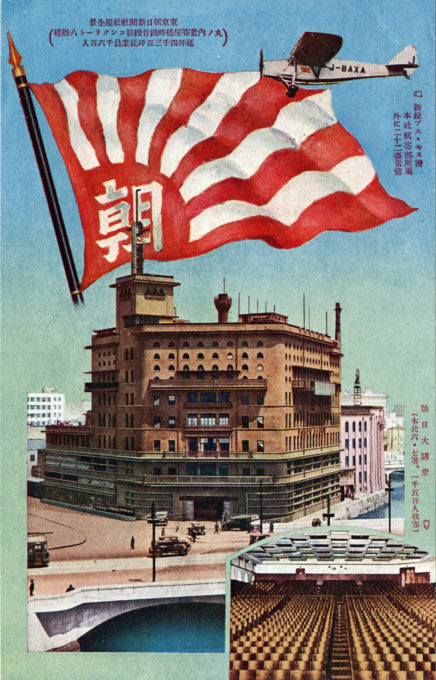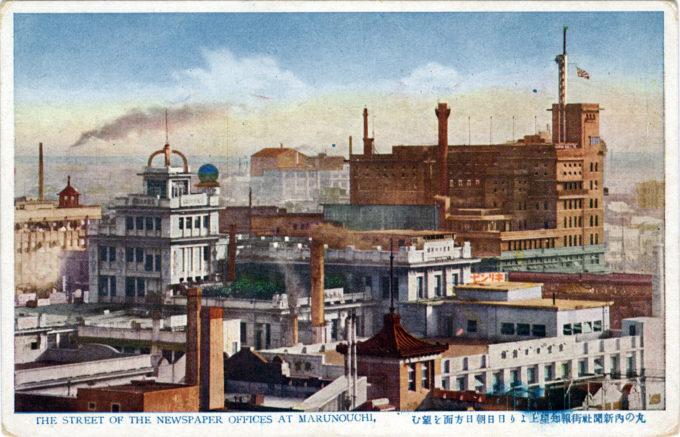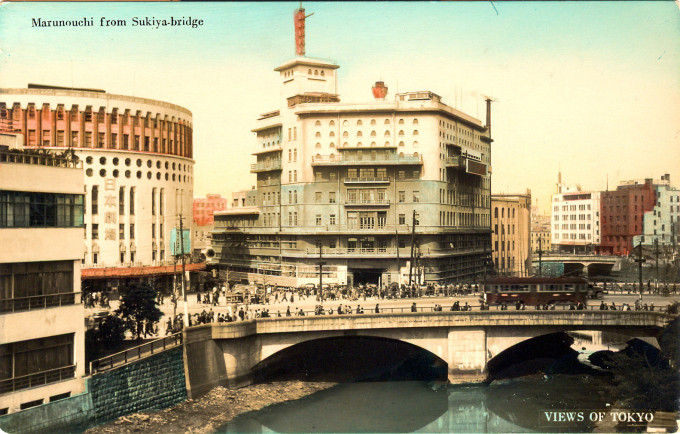
Asahi Newspaper Building, Sukiyabashi, Tokyo, c. 1930, being overflown by a DeHavilland Puss Moth (J-BAXA, christened “Biwa” by the newspaper), one of four airplanes at the time in the newspaper’s press plane fleet. “Asahi” translates to “morning sun”, and the newspaper – while considered liberal and anti-militarist in pre-war years – has throughout its existence used the “rising sun” flag (kyokujitsu-ki) design it shared with both the Imperial Japanese army and navy. While the general display of the kyokujitsu-ki was not allowed during the Occupation (1945-1952) because of its militaristic history, the Asahi was given permission to continue using it as a ‘registered trade mark’.
See also:
Asahi Shimbun, Sukiyabashi, c. 1940
2nd Air-mail Flying Contest, Osaka-Kurume, 1920
Tokyo Nichi Nichi Shimbun (Newspaper), Yurakucho, c. 1920
Nippon Theater (Nichgeki)
“The journalistic world into which Asahi Shimbun (‘Morning Sun’ Newspaper) was born was not the most auspicious. In 1875, the Japanese Government had passed a stiff libel law and was putting editors in jail for ‘dangerous thoughts.’ Yet in 1879, Rhuhei Murayama and Noburu Kimura applied for a license to start a paper with a courageous statement: ‘The newspaper will be edited for easy reading, even by children, with illustrations and other devices . . . for the guidance of the common people, both men and women, young and old, in order to teach them social justice.’ Social justice was hardly the aim of Japan’s authoritarian militaristic Government.
“After the turn of the century, Asahi continually sniped at and embarrassed the traditionalist Government. In 1915, for instance, it published the ’21 Demands’ against China at what the Government thought was the wrong time, and in 1918, it published what the Government thought was too much information about the rice riots.
“During those years, reporters and Murayama were beaten up by right-wingers. It didn’t stop them. By 1925, censorship was worse than ever. Papers were forbidden to publish anything ‘undermining the existing governmental and economic system.’ An Asahi historian has said: ‘Under the forces of totalitarian rule, restrictions on free speech were drawn tighter and tighter; the rattling of sabers became louder and louder. . . . The outward trappings of civilian control remained, but army arrogance was rampant.'”
– History of International Newspapers: Asahi Shimbun in Japan

Elevated view of Asahi Shimbun building (right), Sukiyabashi, Tokyo, c. 1930, looking toward Ginza. The white building at left were the offices and printing plant for the rival Mainichi Shimbun.
“Despite many setbacks, civil air service persisted and improved. Foreseeing the future of flying in 1920, the Government opened the Aviation Bureau to supervise aeronautical affairs while in 1921 the Aviation Control Law was enacted. Four years later the Tokyo Asahi newspaper sponsored the first airmail service between Tokyo and Osaka, by a group called Tozai Teiki Kokukai (East-West Regular Air Transport Association), absorbed in 1929 by the Japan Air Transport Company which converted the line into a passenger route and pioneered mail and general air service throughout the Empire.
“… Japanese pilots have done much to further the prestige of the Empire in civil aviation. Among their achievements was the flight to Europe via Siberia made by a plane of the Asahi Shimbun in 1925, the first [Japanese] plane to venture outside of Nippon. Under the auspices of the same newspaper in 1937 the Kamikaze made a record-smashing flight from Tokyo to London in 94 hours 17 minutes, traveling by way of Hanoi, Karachi, Baghdad, Rome, and Paris.
“Another plane built by the Aeronautical Laboratory of Tokyo Imperial University in 1938 set two world records in a single trip. Remaining aloft for 62 hours 22 minutes and 9 seconds over a 250-mile circuit, the plane traveled a total distance of 7,282 miles.”
– ‘Wings Against the Rising Sun’, Far Eastern Trade, Volumes 1-3, Fall 1940

Asahi Shimbun, Sukiyabashi, c. 1940. To its left is the Nichigeki theater, opened in 1933.

